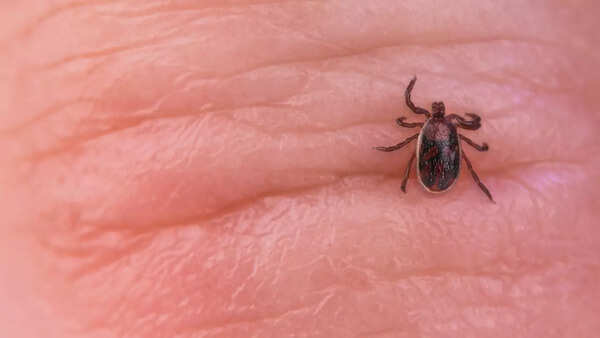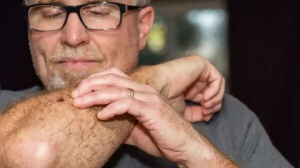Maria Palen, a 31-year-old chemical engineer from California, embodied the image of a fitness enthusiast. With a dedicated plant-based diet and regular exercise, she amassed over 20,000 Instagram followers documenting her health journey. However, her narrative took a dramatic turn when she was diagnosed with babesiosis, a parasitic infection transmitted through tick bites, leading to paralysis from the waist down by late 2024.

Image credit: Instagram/planthlete_maria
Maria's experience serves as a stark reminder that outward appearances of health can mask underlying, invisible battles within the body. Her story highlights the often-overlooked dangers of tick-borne illnesses, particularly for those who enjoy outdoor activities.
Initially, Maria experienced mild symptoms, including inflammation, joint discomfort, and persistent thumb pain. She attempted natural remedies like dietary changes and increased exercise. Unfortunately, her condition deteriorated.
By March 2024, she was largely confined to her bed. Simple tasks became arduous. Eventually, a functional medicine specialist identified babesiosis, a less common tick-borne disease caused by Babesia parasites that invade red blood cells. Unlike Lyme disease, babesiosis often goes undetected due to its resemblance to flu or fatigue. The Centers for Disease Control and Prevention (CDC) reports a doubling of babesiosis cases in the past decade, from 1,000 in 2011 to approximately 2,500 annually today.
Maria suspects she contracted the infection years prior, possibly during a hike, without noticing the tick bite. The infection gradually progressed, ultimately impacting her nervous system. By October 2024, extreme tailbone pain prevented her from sitting, soon followed by paralysis.
Tick bites are often unnoticed due to their small size and lack of pain. A more significant issue is the potential for infections to remain dormant for extended periods. Maria's case underscores the limited awareness surrounding lesser-known tick-borne diseases such as babesiosis, not a lack of vigilance on her part.
Ticks are most prevalent during warmer months, thriving in grassy and wooded environments. The 2024 tick season in the US was particularly severe due to milder winters, resulting in increased survival rates for animals that host ticks. Researchers at the University of California, Riverside, warn that rising tick populations elevate the risk of these rare infections spreading undetected.
The Babesia microti and B. duncani microbes responsible for babesiosis are difficult to detect as they reside within red blood cells. Recent genomic research on B. duncani reveals similarities to the malaria parasite, explaining symptoms such as fever, chills, and muscle aches that can precede more severe complications.
Maria's story emphasizes the importance of early detection in combating tick-borne illnesses. While doctors often test for Lyme disease when a tick-borne illness is suspected, babesiosis is not always considered. Because Lyme and babesiosis can co-exist, symptoms may be misattributed. It's crucial for healthcare providers to adopt a broader diagnostic approach and for individuals to monitor any unexplained changes in energy levels, muscle strength, or chronic pain, particularly after outdoor activities.
The risk extends beyond hiking and camping. Even gardening in overgrown backyards or walking through wooded areas can expose individuals to ticks, especially without protective clothing or repellents.
While standard advice includes wearing long sleeves and checking for ticks, Maria’s case calls for more comprehensive measures:
Newer articles
Older articles
 Esha Gupta Sets Record Straight: Actress Addresses Hardik Pandya Dating Rumors
Esha Gupta Sets Record Straight: Actress Addresses Hardik Pandya Dating Rumors
 Google Maps to Boost Navigation Accuracy with Fused Orientation Provider API
Google Maps to Boost Navigation Accuracy with Fused Orientation Provider API
 Global Vaccination Rates Plunge: Millions of Children Now Vulnerable to Preventable Diseases
Global Vaccination Rates Plunge: Millions of Children Now Vulnerable to Preventable Diseases
 Rishabh Pant: Greg Chappell Hails India Star as Cricket Revolutionary
Rishabh Pant: Greg Chappell Hails India Star as Cricket Revolutionary
 Skin Cancer Alert: How to Identify Suspicious Moles and Early Warning Signs
Skin Cancer Alert: How to Identify Suspicious Moles and Early Warning Signs
 Gavaskar Calls for Kuldeep Yadav's Inclusion in Second Test Amid Bumrah Fitness Concerns
Gavaskar Calls for Kuldeep Yadav's Inclusion in Second Test Amid Bumrah Fitness Concerns
 Is Daily Pooping a Must? Understanding Bowel Regularity and When to Worry
Is Daily Pooping a Must? Understanding Bowel Regularity and When to Worry
 Suryakumar Yadav's Sports Hernia: Understanding the Injury, Recovery, and Risk Factors for Athletes
Suryakumar Yadav's Sports Hernia: Understanding the Injury, Recovery, and Risk Factors for Athletes
 Vijay Sethupathi Apologizes Amid Controversy Over Son Surya's Debut Film 'Phoenix' and Alleged Video Removal Pressure
Vijay Sethupathi Apologizes Amid Controversy Over Son Surya's Debut Film 'Phoenix' and Alleged Video Removal Pressure
 Install Baccarat Hack Tool: The Secret to Winning
Install Baccarat Hack Tool: The Secret to Winning